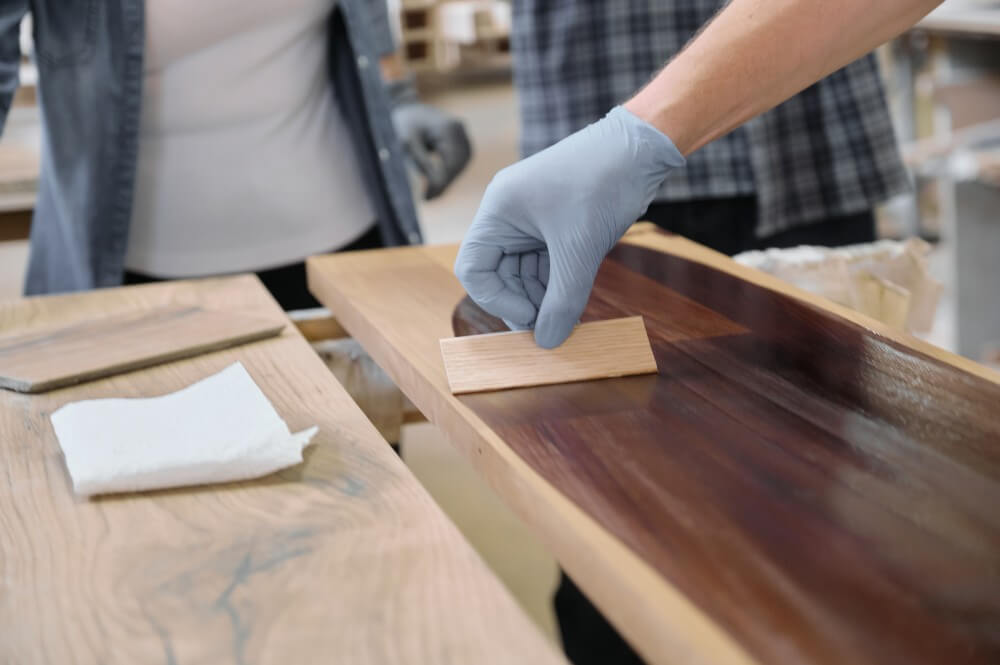- Empty cart.
- Continue Shopping
Your Wooden Furniture: Best Polishing Methods Explained

Households throughout the globe have consistently relied on wooden furniture as their standard choice because of its combination of elegance together with durability and style that never ages. Tables and cabinets with wood craftsmanship give spaces a sense of warmth and sophistication both in classic antique or modern contemporary designs. No matter how exquisite the wood is, neglectful care leads to eventual damage such as scratches and a dull appearance. The correct polishing methods successfully allow people to bring back the natural quality of wooden furniture while maintaining this condition.
This comprehensive guide delves deep into the best polishing methods for wooden furniture, helping you understand what products to use, how to apply them, and how often to do so. Whether you’re caring for a family heirloom or a new wooden dresser, this guide ensures your furniture remains in pristine condition.
Why Wooden Furniture Needs Polishing
Strengthening wooden furniture goes beyond aesthetic purposes since proper polishing remains crucial for maintaining both longevity and visual quality of your pieces. Wood represents an organic porous substance which reacts to modifications in humidity and temperature and sunlight concentrations. The wood gradually dries up when exposed to environmental conditions which leads to cracking while sunlight exposure results in fading.
Wood becomes protected through polishing because the process forms a defensive layer which stops both water penetration and dust accumulation on the wooden surface. Through polishing the natural wood texture and coloring becomes more vibrant while providing an attractive well-kept appearance. The process of regular polishing helps reduce appearance of light scratches and light wear marks to maintain your furniture’s fresh appearance.
After polishing the sheen and fragrance enhances the room atmosphere by naturally brightening the space. Keeping wooden furniture in good condition depends heavily on regular polish application because it sustains both its worth and operational features regardless of tabletop frequency of use or showcase display functions.
Understanding Your Furniture’s Finish
You need to understand the finish present on your furniture before starting the polishing process. The polish reaction to wood surface depends on finish type which controls the final effect.
Common Types of Wood Finishes:
- Varnish: This finish demonstrates enduring protection against water-based substances and alcoholic agents. This finish delivers a glossy hard surface because it appears on furniture that receives heavy usage.
- Shellac: Shellac which originates from natural resin lends wood a warm and rich appearance yet remains vulnerable to moisture and high temperatures.
- Lacquer: Lacquer provides a durable glossy finish along with quick drying time which also provides strong protection for the wood surface. People commonly use this finish to construct modern furniture pieces.
- Oil Finish: When applied to wood surfaces tung or linseed oil permeates through the wood to highlight the natural appearance and create a smooth rubbing effect.
- Wax Finish: It delivers delicate natural-looking protection with a matte texture to wood surfaces. Ideal for antiques and delicate wood.
The selection process for an appropriate finish depends on making the correct identification. The wrong product will either create dimness on the wood surface or bring serious damage to the wood structure. Before polishing the entire piece perform a small test on an unnoticeable spot since this helps determine the appropriate finish.
Preparation Before Polishing
Proper furniture polishing depends on proper preparation as its fundamental base. Doing this step inadequately will produce unsteady polish results and potential permanent wood damage.
Step-by-Step Preparation:
- Dust the Surface: Begin with a microfiber cloth or feather duster because they eliminate dust particles effectively. The application of dust should be avoided since it functions as an abrasive when polishing occurs.
- Clean Thoroughly: Prepare a mixture of dish soap dissolved in warm water. A moistened cloth should gently wipe over the furniture to eliminate accumulations of dirt as well as leftover polish. Surgical precision is required to use a dry towel for immediate drying.
- Inspect for Damage: Thoroughly investigate the furniture surface to look for significant scratches as well as water damage and loss of finishing material. Resolve these problems independently before starting the polishing process. Small scratches can be concealed using touch-up markers as well as wax stick treatments.
- Choose the Right Polish: Choose a polish which properly matches the finish of your furniture. Hicare Furniture Polish serves as an excellent multi-purpose care solution because it will work on diverse wooden surfaces without causing damage.
Top Polishing Methods for Wooden Furniture
Different polishing methods are suited for different wood types, finishes, and desired results. Here’s an in-depth look at the most effective techniques:
- Paste Wax Polishing
The pastewax method offers traditional wood treatment that creates a delicate matte brightness effect. You should use this type of polish to treat high-quality wood items and antique wooden furniture.
- Apply a small amount of wax using a lint-free cloth.
- Rub the wax in a circular motion to spread it evenly.
- Allow it to dry until it forms a haze.
- Buff the surface with a clean cloth to achieve a warm, protective shine.
Paste wax offers long-lasting protection but should be reapplied only a few times a year.
- Oil-Based Polishing
Natural oils such as linseed and tung oil can rejuvenate the wood and feed the natural grain.
- Dissolve a decent amount of oil onto the wood using a soft brush or cloth.
- Let the oil sit for about 30 minutes to 1 hour.
- Carefully wipe up any excess oil to prevent a sticky finish.
- Let the surface dry completely. This typically takes overnight.
Oil-based polishing is more suited to older, dried-out wood for repair and restoration.
- Liquid Polishes
Liquid polishing is desirable and easy to use for your modern, lacquered, wood furniture for regular upkeep.
- Spray a small amount of product onto the surface or cloth.
- Wipe in the direction of the grains
- For a streak-free finish, buff lightly with a soft cloth.
Examples of these product types would be Hicare Furniture Polish, or other liquid based formulations.
- French Polishing
French polishing is time consuming but will yield an excellent, high-gloss glass-like finish. It involves applying many thin layers of shellac using a special applicator called a ‘rubber.’
- The shellac first needs to be applied using either a circular motion or figure-eight pattern.
- When working with each layer, let the layer completely dry before applying the next.
- Oiling with the oil and shellac mixture helps the application to be smooth.
Although French polishing looks beautiful, it is more suited to professionals to execute due to its complexity.
- Cream and Pad Polishes
These are ideal for touch-ups and everyday care.
- Apply a small amount of cream polish or use a pre-soaked pad.
- Wipe across the surface, focusing on smudges or dull areas.
- Buff gently to maintain an even sheen.
These are great for busy households where frequent touch-ups are needed.
DIY Natural Polish Recipes
If you prefer eco-friendly or chemical-free alternatives, consider these DIY recipes:
Olive Oil and Vinegar Polish
- Mix ¾ cup olive oil with ¼ cup white vinegar.
- Shake well and apply with a soft cloth.
- Wipe in the direction of the grain, then buff.
Lemon Juice and Olive Oil
- Combine 2 parts olive oil with 1 part lemon juice.
- Apply to the wood surface using a cloth.
- Buff gently for a citrus-scented shine.
Beeswax and Coconut Oil
- Melt beeswax and coconut oil in a 1:3 ratio.
- Pour into a container and let it set.
- Rub onto wood surfaces with a soft cloth, then buff.
These natural solutions are great for families with children or pets and those sensitive to chemicals.
Using Hicare Furniture Polish
The standout choice for individuals who seek an effective yet easy solution is hicare Furniture Polish. The product merges straightforward application with trustworthy functional characteristics that allow users to clean and restore furniture effectively.
Key Benefits:
- Non-greasy formula that doesn’t leave residues
- Enhances wood grain and provides a lasting shine
- Suitable for daily or weekly use
- Pleasant fragrance
Application Steps:
- Shake the bottle well before use.
- Spray directly onto the surface or a cloth.
- Wipe gently in the direction of the grain.
- Buff with a dry, clean cloth for a polished finish.
Regular application of Hicare Furniture Polish during weekly cleaning sessions keeps your furniture safe from damage and maintains its good appearance.
How Often Should You Polish Wooden Furniture?
The perfect time to apply polish depends on how often you use your wooden furniture combined with the wood type. The result of excessive polishing is product accumulation yet insufficient polishing results in wood dryness along with potential damage.
Recommended Frequency:
- High-use furniture: Every 2-4 weeks
- Low-use or decorative items: Every 2-3 months
- Antiques or specialty pieces: Every 6 months, using appropriate products
Using hicare Furniture Polish as a gentle product means weekly application proves both safe and beneficial for furniture care.
Common Mistakes to Avoid
Even with the best intentions, improper techniques can harm your furniture.
Avoid These Mistakes:
- Using too much polish: Leads to sticky buildup.
- Polishing dirty surfaces: Traps grime and causes scratches.
- Mixing different products: Can result in chemical reactions or cloudiness.
- Ignoring grain direction: Polishing against the grain causes uneven results.
- Using harsh chemicals: Alcohol or ammonia can strip the finish.
Always read product labels and when in doubt, test in a small area first.
Protecting Your Furniture After Polishing
The care strategy contains polishing as one essential practice among many others. Post-polishing protection measures will help maintain your furniture maintenance efforts.
Protection Tips:
- Place mats with coasters underneath pieces to protect from heat and water-related damage.
- You should place your furniture in positions where sunlight cannot reach it directly to stop fading from occurring.
- The indoor environment should stay evenly humid to stop furniture from warping.
- Users should use felt pads to protect the undersides of decorative objects.
- Dust frequently with a microfiber cloth.
These care practices delay how often you need to polish furniture while maintaining its high level of appearance.
Conclusion
Observing proper techniques while using correct products and showing timer care leads to successful furniture restoration. The process of polishing completes a vital role when you care for wood furniture because it helps to protect both its aesthetic appeal and structural integrity. The product selection ranges from classic wax formulas to contemporary chemical solutions which include Hicare Furniture Polish.
Regular polishing and proper maintenance with proper preparation ensure that wooden furniture survives to benefit your home with charm and value into future generations.





